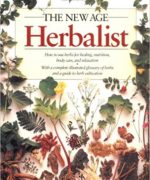The New Age Herbalist presents us with a holistic and nourishing view of our garden and wild-grown plants. These plants are a source of beauty, comfort, food, and medicine. They nourish us on both a physical and a spiritual level.
The New Age Herbalist : How to Use Herbs for Healing, Nutrition, Body Care and Relaxation./ Richard Mabey and Michael McIntyre, 1988. Gaia Ltd., London. Color illustrations.

The New Age Herbalist provides a holistic and nourishing point of view. Throughout the book, you become familiar with natural cures for daily aches and pains, as well as learn the best ways of growing the plants themselves, or acquire knowledge of what the plants look like when full-grown.
If you come down with a cold, should you use ginger? Certainly, if you catch yourself feeling chills or that ticklish-achy feeling that signals you’re getting a sore throat, then ginger comes to your rescue right away. Prepare yourself a tea, as Mabey suggests—made of cinnamon, coriander seeds, cloves, a slice of lemon, and ginger from your kitchen spice rack. If you place these in water, boil and then simmer for a bit, your tea remedy will be ready to go to work and fend off that miserable cold!
Ginger helps rid your body of cold germs before they take over and make you sick.
But what about other herbs—which ones are right for you and your experience of a cold, stomach distress, nervous tension, stiffness in your joints and muscles, ear, eye and skin irritations, female reproductive irregularities, and first aid recommendations? All of these are treated in separate sections of The New Age Herbalist‘s chapter five, “Herbs for Healing”.
The New Age Herbalist is organized thematically and focuses on many holistic features of herbs. In other words you need to investigate the book and find a description of the malady you seek a remedy for and then look up the specific herb(s) you could use.
The New Age Herbalist‘s “Glossary of Herbs” is arranged by plant family names. These are names that denote similarities in the flowers of the plants. For example, all herbs whose flowers have petals arranged around a disk of tiny, closely packed flowers, likely belong to the Aster, or Compositae, family. For herbalists, plant families share qualities that could be useful in identification, or in substitution if such a need arises.
And so the book is very useful in the case you’re gardening, or foraging for herbs, and must be certain you can identify a particular plant.
Yet whatever your purpose in looking through this book, you’ll be fascinated by the diversity of the plants displayed together in full page photographs throughout the glossary. They are unmistakably beautiful.
The New Age Herbalist was written 30 years ago, but its message is timeless. Not only can you acquire lots of information about specific herbs in this encyclopedic book, but suggestions for including herbs in cooking, herbal remedies, and “natural living” are provided. The emphasis on bringing nature, or herbs, into your life, is by now a classic reaction to the stressful lives that we all endure.
An herbal historian would find interesting the cautions given for certain herbs, while some herbs are not part of the Herb Glossary at all. Beyond ginseng, the book’s image of a stressful life in the late 1980s did not reflect an array of adaptogenic herbs. A handful of herbs that now are considered for their medicinal use are listed as primarily culinary—the research and data on some spices would appear a couple of decades later. Turmeric is one of these. Tulsi or Holy Basil is not mentioned. Also, I wondered why Gotu Kola was a “restricted” herb in this time, and why no description appears for Ginger, or for Comfrey.
Richard Mabey is the author of numerous books evident of his commitment to knowing and appreciating nature. Because of his personal dedication and because of the book’s vintage quality, having first been published in the late twentieth century, I would want this book in my library. The information on a given herb’s value as a remedy, for body care, home care, or instructions on growing it, are the contributions of authors Mabey, McIntyre, and Pamela Michael, Gail Duff, and John Stevens—all published in either herbs and wild plants, cultivating them, or in nutrition.
The New Age Herbalist is an example of a community of like-minded writers who produced a comprehensive body of work on a subject that we usually expect to come from an herbalist or naturopathic doctor (and their team(s)). Why should we buy their books and follow their advice? The whole idea is to involve us in the daily use of herbs for health, much the way we view wholesome food—for our health. The New Age Herbalist provides a holistic and nourishing point of view, for the body and the spirit.



